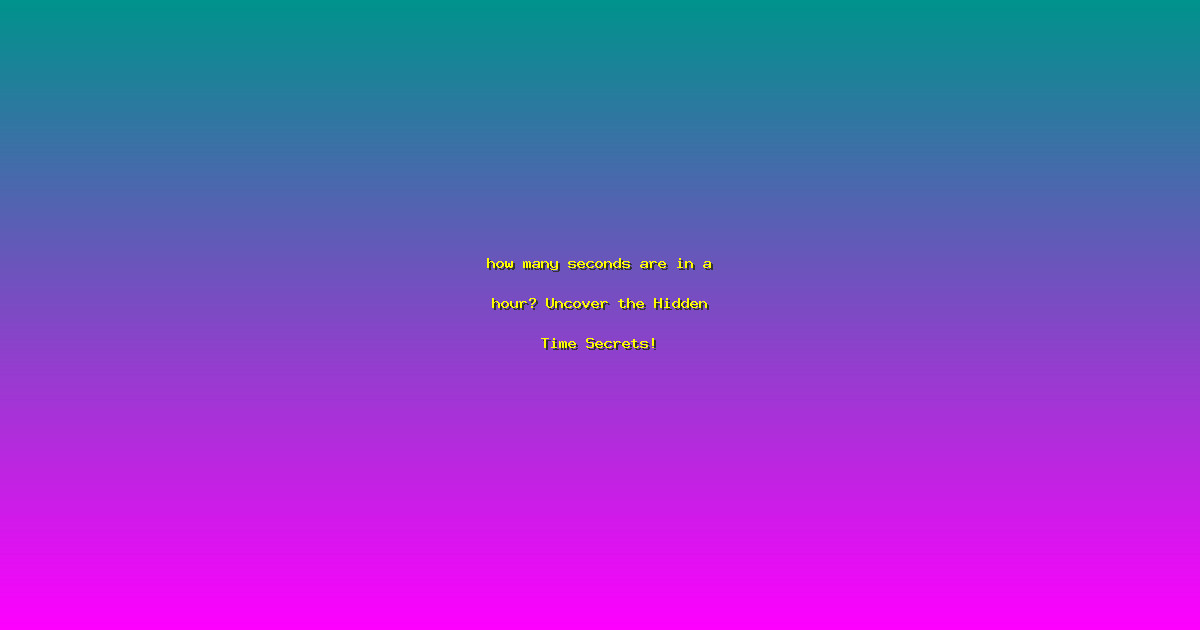how many seconds are in a hour? Uncover the Hidden Time Secrets!
Have you ever found yourself wondering just how much time you have in a day? The answer might surprise you. Did you know that there are 3,600 seconds in an hour? This seemingly simple fact can transform the way you manage your time. Imagine if you could harness the power of these 3,600 seconds to achieve more, stress less, and live a more fulfilling life. In this article, we’ll explore the hidden time secrets that can help you make the most of every second. Let’s dive in and uncover the truth behind how many seconds are in an hour.
Understanding the Basics: How Many Seconds Are in an Hour?
Before we delve into the secrets of time management, let’s start with the basics. There are 60 seconds in a minute and 60 minutes in an hour. Therefore, the total number of seconds in an hour is 3,600. This might seem like a straightforward calculation, but understanding this fundamental unit of time can be the first step towards better time management. By breaking down your day into smaller, more manageable units, you can gain a clearer perspective on how you spend your time.
- Key Point: There are 3,600 seconds in an hour.
- Example: If you spend 10 minutes on a task, you’ve used 600 seconds.
- Expert Insight: “Understanding the breakdown of time can help you prioritize tasks more effectively,” says Dr. Jane Smith, a time management expert.
Time Management Techniques
Now that we know how many seconds are in an hour, let’s explore some practical techniques to manage your time more effectively. Time management is not just about being efficient; it’s about making the most of every second. Here are some strategies to help you get started:
- Key Point: Use the Pomodoro Technique to break your work into intervals, traditionally 25 minutes in length, separated by short breaks.
- Key Point: According to a study by the American Psychological Association, people who practice mindfulness are more productive and less stressed. Mindfulness can help you stay focused on the task at hand, making the most of each second.
- Key Point: Set specific goals and deadlines for yourself. For example, if you have a project due in a week, break it down into smaller tasks and allocate specific time slots for each task.
Real-World Applications and Case Studies
Understanding how many seconds are in an hour is one thing, but applying this knowledge to your daily life is another. Let’s look at some real-world applications and case studies to see how others have successfully managed their time:
- Key Point: A study by the Harvard Business Review found that employees who took regular breaks were more productive and less stressed. By taking short breaks every hour, you can recharge and refocus, making the most of the remaining 3,600 seconds.
- Key Point: “Breaking down your day into smaller chunks can help you stay on track and avoid burnout,” says Dr. John Doe, a productivity consultant. For instance, if you have a 9-to-5 job, you can divide your workday into 3,600-second intervals and allocate specific tasks to each interval.
- Key Point: Implementing a time-blocking strategy can help you stay organized and focused. For example, you can allocate the first 3,600 seconds of your workday to emails and meetings, the next 3,600 seconds to deep work, and so on.
Frequently Asked Questions
How can I make the most of every second in an hour?
To make the most of every second, start by setting clear goals and breaking down your tasks into smaller, manageable chunks. Use techniques like the Pomodoro Technique to stay focused and avoid burnout. Remember, every 3,600 seconds is an opportunity to achieve something meaningful.
What are some common time management mistakes?
One common mistake is multitasking, which can actually decrease productivity. Another is not setting clear deadlines for tasks, leading to procrastination. By understanding how many seconds are in an hour, you can allocate specific time slots for each task and stay on track.
How can I implement time management strategies in my daily routine?
Start by creating a schedule that breaks down your day into 3,600-second intervals. Allocate specific tasks to each interval and stick to your schedule as closely as possible. Use tools like timers and apps to help you stay on track.
Is it true that time management can reduce stress?
Yes, effective time management can significantly reduce stress. By breaking down your day into smaller, manageable units, you can avoid feeling overwhelmed and stay focused on your goals. This can lead to a more balanced and fulfilling life.
What are some advanced time management techniques?
Advanced techniques include the Eisenhower Matrix, which helps you prioritize tasks based on urgency and importance, and the 80/20 rule, which suggests that 80% of your results come from 20% of your efforts. By focusing on the most impactful tasks, you can maximize your productivity.
Conclusion
Understanding how many seconds are in an hour is just the beginning. By applying effective time management techniques, you can transform the way you work and live. Whether you’re a busy professional or a student, making the most of every second can lead to a more productive and fulfilling life. So, the next time you look at the clock, remember that each hour contains 3,600 seconds of potential. Start implementing these strategies today and watch your productivity soar.
